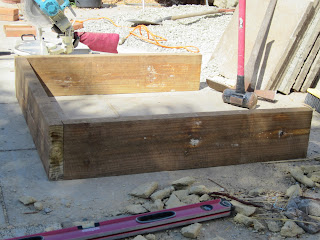Richard is nearly finished in the garden, and I'll put up pictures soon, but for the moment I'm busy getting excited about actually getting to plant stuff in the vegetable beds. The first one we will tackle is the closest to the tap and closest to the house. It is a 1m x 1m bed and will be exclusively for herbs and leaves.
I've been thinking around in circles of how to plant this bed, as half the herbs I want to plant are perennials and so will stay in place once planted, and the rest are annuals, so will need to be replanted constantly. I came across a great method called "Square Foot Gardening" developed by an American chap called Mel Bartholomew in the 80s. Here's an example from another garden:
The idea is that you plant everything in raised beds, which you divide up into 1 foot squares. You think of everything you plant then in terms of a single square foot, and there is a list of how many of each type of plant you can fit in each square. So in our bed we will fill it with compost, lay reticulation, then mulch, and lay down a 25cm grid (close enough to a foot to still work) made of thin strips of wood. Then to plant each seed we will scrape back a bit of mulch and plant in a little hole. As the plant grows we can tuck the mulch back in around to conserve water, and still be able to see the grid.
No digging is needed between seasons, it seems, so i'll add a handful of good compost with each seed that gets planted to start a good habit and water with chicken poo water (water with a bit of chicken poo in - high tech) to keep the soil good.
This is what I'm hoping to plant, and need to pick whether we'll go from seed or get little starter plants. Maybe plants for the perennials and seed for the annuals. The perennials take up the top half and are taller (hence being at the northern end of the bed) and the annuals are at the bottom in the southern half.
The number under the herb is the amount that can be planted in the square. For 1 plant, it goes into the middle. For 4, it is planted in a 2 x 2 grid. For 9 it is a 3 x 3 grid. Carrots and little things like beets and onions get put in up to 16 per square.
This method is claimed to produce the most output from the least space and water. Mel says that a well prepared system can take as little as 1 hour of gardening input time a week to maintain, as weeds are not really a problem as there is no space left for them! Rows make sense for a large field where you need space between to walk/drive on, but in a little bed like this we will never stand in it and it will be filled with great rich soil all the time, so we can grow very intensely. It sounds pretty promising!
Hopefully this will all kick off next weekend and I'll get lots of pictures up. Fingers crossed for square foot gardening!


















